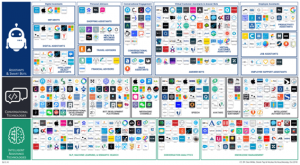
How chatbots drive growth and efficiency
Next-generation chatbots are key to business
efficiency, communication and growth. This is what “they” can do for you.
Chatbots came a very long way from their humble beginnings as simple conversation simulators. A few years ago, you’d be lucky to get a coherent response from pre-determined keywords and prompts (remember Facebook’s early pre-set responses?). Today, they can analyse spreadsheets, generate complex email responses tailored to customer data, and save countless hours in repetitive, manual tasks. Furthermore, they can detect patterns and issues that are not obvious to humans, thanks to innovations from Machine Learning, Natural Language Processing, and Deep Learning.
What is a chatbot?
In broad terms, chatbot is any software that imitates human-like communication with a user in a chat. They can engage a potential customer in a conversation, capture their contacts, deal with queries or introduce your service by telling about its main features.

Global chatbot market size. Source: Predence research
Chatbots can range from simple, rule-based systems that respond to specific commands with pre-defined answers, to more advanced AI-driven bots that can understand natural language and generate responses that mimic human-like conversations.
Chatbots are used in a variety of applications, such as customer service, information retrieval, and even for entertainment purposes. They can be integrated into websites, internal apps, messaging apps, and social media platforms to provide users with immediate responses to queries, guidance, or assistance. The technology behind them continues to evolve, making interactions more seamless and enabling them to handle more complex conversations.
A brief history of Chatbots
The first ever chatbot was named ELIZA. Created in 1966 at the MIT, ELIZA, then called “chatterbot”, was designed to simulate a Rogerian therapist – that is, to provide empathic responses to users’ inputs. It relied on a technique called pattern matching, where it would detect certain keywords and respond accordingly. For example, if a user said to ELIZA that they were depressed, the chatbot would reply something like “I am sorry you feel that way.”
A few years later, in the early 70’s, PARRY ushered in a new era for medical chatbots. PARRY simulated a person with paranoid schizophrenia and was used by medical students to learn to communicate with patients. After that, chatbots became increasingly sophisticated, and soon enough came Racter (1983), a chatbot that generated random English prose, Dr. Sabaitso (1991), another psychologist chatbot, and a multitude of conversationalist chatbots like A.L.I.C.E. (1995), Jabbewacky (1997), Cleverbot (2008), introduced the technology to a wider audience.

Chatbot landscape. Source: Micope
The 2010’s brought advancements in Machine Learning, which made it possible to create chatbots that could “learn” from data, and do simple tasks like book appointments, process orders, or even assist with simpler customer service issues. The rise of AI propelled them forward. We now have at our disposal weather bots, news bots, bots to help with ordering groceries, personal finance bots, scheduling bots, therapy bots, and even life advice bots or friendship bots.
What kinds of chatbots are there?
There are, essentially, two types of chatbots:
- Rules-Based Chatbots: Rules-based chatbots rely on pre-defined sets of rules and keywords to respond to user queries. These are also called decision-tree chatbots, and they usually deliver pre-programmed responses, for example in the form of a menu. These have greatly evolved over the years, and are still widely used, for example, in customer service by airlines, banks, e-commerce, or the hospitality sector. They are simple and easy to implement, and while they are generally quite secure – as they follow a script – they struggle with more complex queries.
- AI-Powered Chatbots: now this is where things get more interesting. AI-powered chatbots leverage Machine Learning, Deep Learning and Natural Language Processing to handle complicated queries from users. AI chatbots “learn” from user interactions and are able to tailor their responses to the specific user. These chatbots can be used in customer service, but also for education and training, for healthcare, for marketing and sales, for HR purposes, or for internal operations.
Finally, chatbots can also be hybrid, meaning they can be AI-powered but follow a rules-based approached.
Chatbot benefits
Chatbots are rapidly changing the way businesses operate. So, what can it do for your business, concretely?
- Automating repetitive tasks: Chatbots can easily handle queries like password resets and software troubleshooting, HR queries such as leave requests or PTO, and administrative tasks such as scheduling meetings, booking meeting rooms, and generating expense reports. Freeing your employees from these time-consuming tasks, allows them to focus on other projects that effectively require human intervention.
- Knowledge Base Management: Chatbots can act as on-demand knowledge bases, providing users with easy access to information, in a conversational way. Chatbots can retrieve information easily from centralised repositories be it for company procedures, policies, and best practices, for product specs and pricing, software troubleshooting guides, FAQs, and many more.
- On-The-Job Training: Chatbots can guidemployees through various processes, best practices, and compliance measures. Additionally, chatbots can offer bite-sized training modules and answer specific job-related questions, provide ongoing support and micro-learning opportunities, ensuring your team stays up-to-date without the need for extensive onboarding processes, or intensive education sessions.
- Improved Communication and Collaboration: Chatbots can mediate between teams, departments, and customers. They facilitate messaging, schedule meetings, and improve knowledge sharing, helping cultivate more collaborative and connected work environments.
- Personalized Support: Users can use chatbots as on-demand support systems for guidance and recommendations. An internal chatbot can help an employee solve a problem on a task, navigate a new software, or even fetch similar past issues from the knowledge-base.
- Feedback: Everybody knows feedback is key. Chatbots can be implemented as anonymous feedback channels, through which users can report issues, share suggestions, or raise concerns without pressure. This feedback provides valuable insights to improve processes and the overall experience.
- Data Collection and Analysis: Chatbots can process vast amounts of data to identify trends, potential risks, workflow bottlenecks, opportunities for improvement, and others, and provide insights.
- Reduced Operating Costs: By greatly reducing the tedious administrative burden, internal chatbots can contribute to significant cost savings. The more streamlined the operations, the more resources available to invest in strategic growth initiatives.
How to implement Chatbots in your business
The story of chatbots is still being written, and AI is yet another chapter. As technology continues to evolve, we can expect chatbots to become even more sophisticated, blurring the lines between human and machine interaction and further revolutionising the way we work and live. But, although chatbots can seem like real do-alls, implementing chatbots seamlessly into your existing workflows requires careful planning. Here are some steps to consider:
- What does your business need from a chatbot? Is it automation of menial tasks, improved communication, progress tracking, knowledge base management? It is important to know what your business’ needs are.
- What is the chatbot’s purpose? Having a clearly defined purpose for your chatbot ensures it can be programmed to offer targeted support and excel at that, rather than becoming a catch-all for miscellaneous queries.
- Pre-built or from-scratch? There are dozens, if not hundreds, of chatbots dedicated to pretty much anything you can think of. Is there any that can suit your business’ needs? Do you need to have it built from scratch? Are you using a platform that offers integrated AI chatbots?
- Who will be using it? Chatbot implementation depends on who will use it. For employees who don’t have technical expertise, the priority should be a conversational interface and general user-friendliness.
Not sure how to proceed? At Near Partner, we’re ready to lend a helping hand. Our team has vast experience with AI, including in building chatbots from scratch, customizing Salesforce Einstein bots to integrate seamlessly with your legacy systems, or crafting personalised chatbot experiences within the OutSystems environment. We’ll help you navigate the options and choose the best solution for your business needs.
Get a free consultation with one of our experts. Leave your email and we’ll get back to you promptly:



